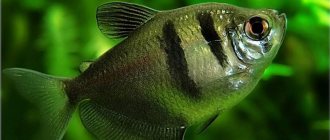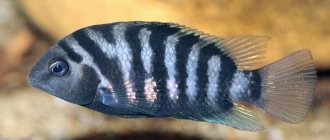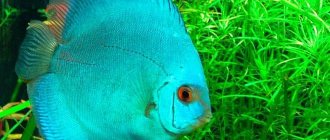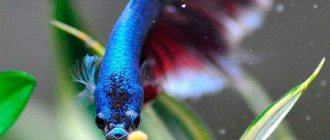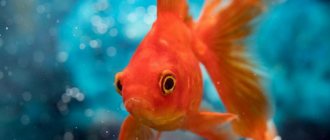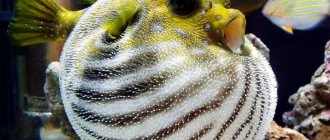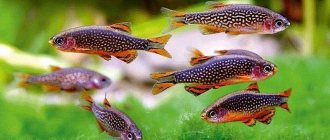Ornatus is a delicate small aquarium fish from the characin family. In the aquarium, she behaves calmly, treats decor and plants with care, and does not dig in the soil. Such residents are ideal for herbalists, where the richness and well-groomed vegetation remains in the first place. Keeping an ornatus is not difficult, but you need to know the appropriate parameters and stick to them so that the fish lives long and is healthy. Even beginners, not to mention experienced aquarists, can handle this task quite well.
Description
Signs similar to all types of phantoms: a laterally compressed flat body measuring from 4 to 6 cm, wide in the middle: from the dorsal fin to the tummy. The dorsal fin is narrow and high, shaped like a flag. The anal fin extends from the middle of the body to the tail. A little closer to the head, at some distance from the anal fin, there are pelvic fins, also noticeable and bright. The tail is two-lobed, the long outer rays are at a large angle to each other, which is why the tail looks wide, but small.
General information
Platydoras armatulus is a freshwater fish from the Armored catfish family.
The first scientific descriptions date back to 1840, and the fish was named Platydoras costatus. But in 2008, scientists revised the systematic position of the fish and identified it as a separate species. The name of the genus consists of two Greek words: “platys” - flat, wide and “doras” - shell, which indicates the serious protection that nature gave the catfish: strong skin, a developed occipital shield and bone growths along the lateral line with spiny bone scutes.
Platydoras are not picky about their living conditions and are good aquarium orderlies, eating up leftover food that falls to the bottom.
An interesting feature of these catfish is the ability to make sounds. They can do this in two ways: by rubbing the pectoral fins against the grooves in the shoulder joints (a chirping sound is produced) and by quickly contracting and relaxing the muscle attached to the skull on one side and the swim bladder on the other. This “spring” produces sounds similar to drumming.
Catfish make sounds when meeting other individuals or when frightened. You can hear them if you catch them from the aquarium or even just by listening (it is advisable to do this after turning off the lights).
Long spines on the body and fins can easily tear the net, so you need to be careful when catching catfish. Often young platidoras can be found in the company of larger predatory fish, for which they act as “cleaners”, eating parasites and dead scales on the body, although this behavior is more typical for marine fish than for freshwater ones
In adult catfish, such a desire to help their neighbors is not observed.
Often young platidoras can be found in the company of larger predatory fish, for which they act as “cleaners”, eating parasites and dead scales on the body, although this behavior is more typical for marine fish than for freshwater ones. In adult catfish, such a desire to help their neighbors is not observed.
Platidoras are predominantly nocturnal and like to burrow into soft soil.
Kinds
Phantom fish has several varieties that differ in color, size and even behavior. Most species are the result of selection. In all fish, sex differences are expressed in the shape and size of the fins.
- Ornatus vulgaris - the body is elongated, bronze-pearl-colored, translucent. There are two red dots on the tail, and the pectoral fins are also tinged with red. The dorsal and anal fins are small and harmonious in size. May be red or body color. The dorsal fin has a black dot edged with white. White markings may be on the tips of the fins. Sometimes you can find a black border on the fins, and a black vertical stripe behind the gills. This is a sign of natural color and is rarely found on sale;
- Red phantom (red ornatus) - the main body color is cold red (ruby), rich on the muzzle, becoming more transparent towards the tail. The tail is black, with a white or translucent silver edge. Males have a black spot on the dorsal fin. Behind the gills, an oblong black spot is bordered with golden-pink. The fish are bright, but are more demanding of water parameters than others;
- Black phantom (black ornatus) - has a gray-silver translucent body, the color becomes more intense closer to the tail. The tail is black, the remaining fins repeat the color of the body. Behind the gills on each side there is a short oblong black spot, and the gills themselves under the eyes are reddish. The dorsal fin is lush and high, and is an ornament and distinctive feature of the fish;
- Ornatus whitefin - the appearance is similar to an ordinary phantom, only the black spots are replaced with white, and the fins themselves are a little more transparent;
- Ornathus pink - similar to ordinary ornathus, but lighter and without characteristic spots. The main color is with a pinkish tint, the fins are the same color, with faint red markings;
- Rubrostigma (Ornatus red dotted) - the body is painted in a pale silvery hue, thanks to the translucency, the reddish spine is visible through the scales. Red markings are present at the base of the caudal fin and on the gills. In the center on each side is a small, clearly defined pink spot. The border around the eye is also marked with a pink dot.
There are several fish whose names include the word “ornatus,” but the fish itself has neither physiological nor morphological connections with ordinary phantoms.
- Julidochromis ornatus is a small cichlid with an elongated body and a nasty predatory character;
- Pseudotropheus elongatus (Elongatus ornatus) is also a cichlid with the aggression, habits and character inherent in this family.
Dangerous golden parrot in an aquarium
Don't be fooled by the name of the fish, Julidochromis ornatus!
In fact, this julidochromis has nothing to do with true ornathus! This cute fish with a slender, torpedo-shaped body differs from phantoms not only in appearance, but is also “famous” for its extremely bad character towards its neighbors. Yulidochromis may well commit a raider seizure of someone else's living space, since he loves to settle in all sorts of caves and snags, where peaceful and gentle ornathus of all kinds live . And during the period of “creating a family,” the Golden Parrot (the second name of the fish) can easily kill other fish in the aquarium, deciding that they are encroaching on its territory.
Of course, Julidochromis ornathus can be kept in a community aquarium, but only with those fish that are capable of giving the Golden Parrot a worthy rebuff. And these will not be neons with nannostomus at all, but fish belonging to the same family as Julidochromis itself - Cichlididae (Cichlids). For example, Elongatus ornatus.
Maintenance and care
Setting up an aquarium does not require special skills, the main thing is the stability of the reservoir. Maintaining parameters familiar to fish is the main task of the owner.
Arrangement of the aquarium
- The volume of the aquarium is calculated using the formula 10-12 liters per fish. Since Ornathus is a schooling fish, an aquarium of 60 liters or more is suitable for a group of 6 fish (minimum number);
- The lighting is dim, only for illuminating the aquarium. If we are talking about an herbalist for whom light parameters are important, make sure that there are plants with wide leaves that create shade;
- Any soil is suitable; ornathus are not very interested in it. The main thing is to carry out regular cleaning with a siphon, since food debris clogged between the stones worsens the quality of the water;
- The decor can be plants (they need to be planted so that there is space for swimming), grottoes, piles of stones that create shaded corners. Driftwood is good for softening water;
- It is advisable to have a lid.
Water parameters
- Water temperature 20-24°C. The value must be stable; changes, especially sudden ones, should not be allowed;
- Hardness 3-12dgH;
- Acidity 5.5-8.0 pH;
Filtration and aeration
- The filter comes with adjustable pressure: phantoms don’t really like flow. It is better to organize aeration separately from filtration, using a special compressor;
- The purity of the water should be maintained by regular changes (1-2 times a week up to 25% of the volume, depending on the ratio of volume and number of fish). When making changes, pay attention to the temperature of the fresh water: it should be identical to the aquarium water;
Habitat
Endemic to the upper basin of the Orinoco River (South America), it is found in its numerous tributaries in the territory of the modern states of Colombia and Venezuela.
It lives in small rivers and streams, in the canopy of flooded areas of tropical forest, temporary lakes, as well as in the canals of main rivers. Brief information:
- Aquarium volume - from 80 liters.
- Temperature - 20–24°C
- pH value – 4.5–7.5
- Water hardness – mostly soft (1–12 dGH)
- Substrate type - any sandy
- Lighting - dim
- Brackish water - no
- Water movement - moderate to weak
- The size of the fish is about 3.5 cm.
- Food - any food
- Temperament - peaceful
- Maintain a flock of at least 8–10 individuals
Behavior and Compatibility
The description of Ornatus suggests that this fish is peaceful. Its disposition is similar to neons, rasboras, and guppies. Despite the fact that it is considered a schooling fish, under satisfactory conditions without stress, phantoms swim on their own. They gather in a group only when there is danger or in the presence of an irritating factor. Phantoms, constantly swimming in a school, signal by behavior: there is a source of stress in the biotope, which means the fish are uncomfortable and will not live long. Ornathus live in a home aquarium for 3-5 years, and life expectancy directly depends on the amount of stress experienced.
Ideal neighbors for ornathus are the phantoms themselves and most peaceful small catfish. In addition, tetras, platies, pulcheras, and swordtails are suitable for keeping together.
Large predators, small predators, and fish that are too fast and fussy are not suitable. They pose a threat to the moral and physical existence of ornathus.
Ornatus - peaceful neighbor
The fish themselves are very, very peace-loving creatures: even males, during territorial disputes, only get closer, adopting a threatening pose - bending their bodies and spreading their fins widely, but it never comes to a fight or injury.
They get along with other peaceful inhabitants of the aquarium: cyprinids, thorns, gouramis, ancistrus or acanthophthalmus. They are generally good neighbors, always ready to team up if a new fish appears in the aquarium or they feel some kind of threat. But aggressive and large fish are pure evil for Ornathus!
Reproduction and breeding
To breed ornathus at home, you will need a spawning aquarium with the following parameters:
- Volume 30 l, water level 15-17 cm;
- Temperature 26-28 °C;
- Hardness 1-5 gH;
- Acidity 5.5-6.5 pH;
- There is no artificial lighting; the aquarium must be protected from natural lighting;
- Java moss;
- Mesh on the bottom.
Spawning requires a school of fish in a 1:1 sex ratio. How to determine the sex of Ornathus: usually males have a sharp and large dorsal fin, and sometimes all other fins are larger than those of the female. The female has a more rounded body shape with a prominent abdomen.
Reproduction should begin by adjusting the diet at least two weeks before the expected spawning. Phantoms are switched to live food with a high protein content. Then they are transplanted into a special aquarium, where spawning should begin within 24 hours.
During spawning, the female lays eggs on the leaves of Java moss or on a net through which the eggs fall to the bottom. After spawning, the fish are placed in a common aquarium. The fry are fed live dust, Artemia nauplii, and ciliates, and then switch to starter feed. As the young grow older, they are transferred to adult food, after which the fish can be moved to a common aquarium.
Useful video
Check out this interesting video about keeping fish:
Ornathus are truly beautiful and easy-to-care aquarium fish. Before purchasing such tiny creatures, you should properly arrange your future home. To do this, the optimal temperature regime is selected, the correct water indicators are created, and neighbors are chosen wisely. Proper care will prolong the life of the fish and eliminate the risk of disease. Previous
Fish: Is the black knife or black prince an aquarium fish?
Next
Fish7 types of food for betta fish
Diseases
Ornathus have a strong immune system, which helps them practically not get sick. Fish are mainly susceptible to bacterial and parasitic infections; they easily tolerate medications added to the water. Diseases of this kind manifest themselves in the appearance of plaque on the body, frayed fins, lethargy, and dull eyes. The sooner treatment is started, the greater the chance of saving the fish’s life.
Prevention of diseases consists of timely and complete proper care of the aquarium: cleaning the soil, changing water. Equipment, decor and everything that goes into the aquarium must first be disinfected. Live food should only be purchased clean, from trusted places. Choose high-quality dry food. All new residents must undergo quarantine before being moved into phantoms.
Feeding
Ornathus enjoy eating high quality dry food. It is better to refuse live and frozen fertilizers. The most popular brands:
- TetraMin . Great for all types of decorative fish. It is characterized by a high content of nutrients and easily digestible components. Sold in flakes and mini-pellets.
- TetraPro Colour . Includes natural color enhancers. Suitable for feeding red fish. The result is noticeable within a few weeks.
- Tetra Micro Crisps . They are mini chips, which in turn come in green and red. The former support health and vitality, the latter enhance color due to natural carotenoids.
General information
Clarias are freshwater ray-finned fish from the Clariaceae family. These are quite large catfish with an elongated eel-like body and 4 pairs of antennae on the head. The name of the genus comes from the Greek word “chlaros”, which translates as “living, tenacious”. And it is connected with the amazing ability of clarius to stay out of water for a long time. This is facilitated by a special epibranchial organ, which allows the use of atmospheric air for breathing, and an abundant amount of mucus secreted by the skin, which prevents the fish from drying out.
Currently, the Clariaceae genus includes more than 60 species of catfish, distributed in Africa and Southeast Asia. Many of them are of commercial importance. The meat of these catfish is considered dietary. It does not have a specific fishy smell, small bones or fat, and has a high content of amino acids and vitamins.
Clarius is an important fishery target
Only a few species of these catfish are popular in the aquarium hobby.
It is important to consider that they are all giants compared to most species of aquarium fish. Body length can reach 50-70 cm
In addition, Clarius is a predatory catfish, and it can only be kept with very large fish.
Due to the similarity in appearance, clarius are often confused with sacbranch catfish. However, it is quite easy to distinguish them, because the former have a long dorsal fin, while the latter have a short one. Their air breathing organs also differ: in clarius it is a spongy epibranchial organ, and in pouchbranch catfish there are special pouch-like outgrowths on both sides of the back.
Another interesting feature of clarius is the ability to produce light electrical impulses, with the help of which the fish communicate with each other.
In the aquarium, Clarius catfishes very quickly remember the owner and even allow themselves to be stroked.
In the USA and Europe, Clarius is also known as the “Walking catfish”. Indeed, when the reservoir dries up, clarius are able to cover a distance of up to 5 km in search of a new home. Vigorous movements of fins and mucus allow catfish to move at fairly high speeds.
